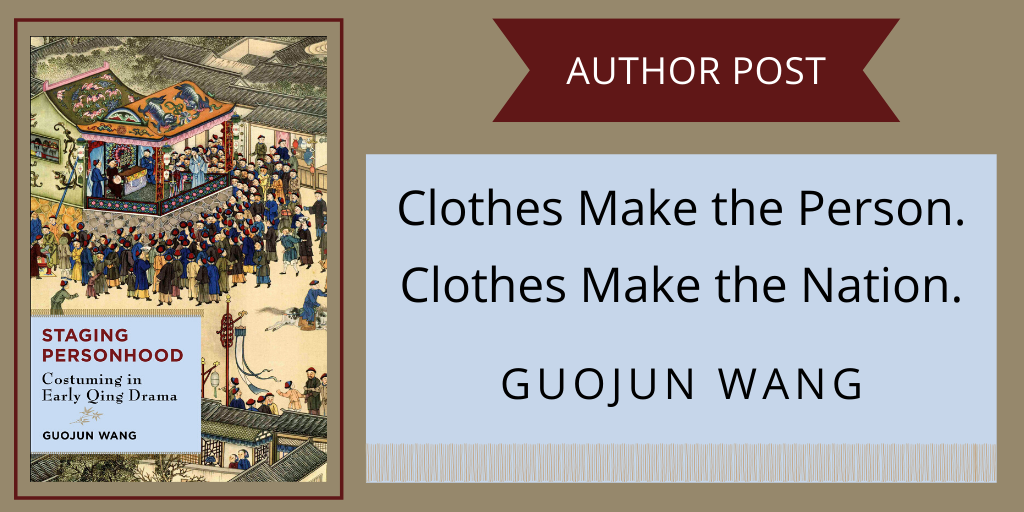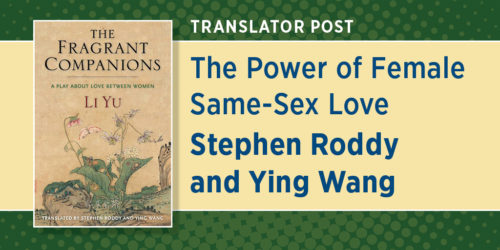Clothes Make the Person. Clothes Make the Nation
By Guojun Wang

“A marvelous piece of scholarship, Staging Personhood presents an exhaustive study of the function of clothing on stage and off. While speaking to issues of sexuality, gender, masculinity, and status in real society, the book goes beyond the existing literature to introduce the body as a symbolic marker and site of detailed and sustained discourse.”
~Stephen H. West, coeditor of The Orphan of Zhao and Other Yuan Plays: The Earliest Known Versions
What can clothing tell us about history, culture, and self-identity? In this guest post, Guojun Wang, author of this week’s featured title, Staging Personhood: Costuming in Early Qing Drama, unveils the history of China’s clothing politics during the last imperial dynasty.
Remember to enter our drawing for your chance to win a copy of the book!
• • • • • •
Clothes make the man, as the old saying goes. Clothes also make the nation, or represent a nation––if you think about the national costumes world leaders wear at important Asia-Pacific Economic Cooperation summits. Styles of fashion most directly communicate national ethos, ethnic dynamics, religious traditions, personal taste, social status … the list continues. We should not forget, though, that prohibiting certain ethnic dress was an important tool of colonial rule in sixteenth-century Ireland, eighteenth-century Scotland, and twentieth-century South Asia. Social changes are so markedly registered on fashion styles that a glimpse of women’s dress before and after the Iranian Revolution (1979) quickly reminds one of the ongoing struggle between past and present, religious and secular lives. In China, likewise, controversies regarding Muslim clothing for Uyghurs in Xinjiang frequently make the headlines of global newspapers. Meanwhile, the worldwide Han-clothing movement signals a perennial longing for a cultural lineage out of the flux of ethnic and cultural symbols that constitute the Chinese tradition.
Staging Personhood: Costuming in Early Qing Drama uncovers hidden stories about clothing, literature, and individual persons at a particular time in Chinese history. Clothing did its fair share in helping to make China’s last imperial dynasty. When the Manchu rulers toppled the Ming dynasty (1368-1644) and established the Qing dynasty (1644-1912), they forced all Han Chinese males to adopt Manchu clothing and, more important, the Manchu hairstyle featuring a shaved pate and a hair queue. Viewing the Manchu styles as barbarous, Han Chinese people, steeped in the Confucian teaching about civility, strongly resisted, even at the cost of their lives. That transitional period marked one of the bloodiest moments in China’s history of clothing politics. The Manchu Qing dynasty, accordingly, has been labeled an evil Other to the Han Chinese sartorial tradition.
“Viewing the Manchu styles as barbarous, Han Chinese people, steeped in the Confucian teaching about civility, strongly resisted, even at the cost of their lives.”
As the clothing changes continued for decades in mid-seventeenth-century China, they were represented in various literary and artistic genres. Poets lamented their loss of culture; painters portrayed themselves and their fellow loyalists wearing styles of the defunct Ming dynasty. Drama and theater became a particularly complicated arena. Drama scripts recorded individual experiences of these changes. As told in one play, a family traveled to China’s southwest frontier before the dynastic change and returns home to eastern China afterward. When crossing the border into Manchu territory, the male members have to change into Manchu dress. The upheavals of the time and the decade-long sufferings of a family are condensed into a moment of costume change at the border between past and future, en route to a former home turned alien land. In another play, a young scholar changes into women’s clothing to avoid shaving his head, because Han women were exempt from the Manchu dress regulations. After the political and sartorial transitions, however, he finds himself trapped in a female identity and becomes a stranger in his own home. What one wears determines not only political affiliation but also gender identity.
“On the one hand, traditional Han clothing was preserved in drama performances onstage; on the other, the Manchu government prohibited the use of Manchu clothing in popular drama performances because it deemed theater a depraved practice of the Han Chinese.”
Costumes used for play performances also occasioned divergent experiences among different groups of people. On the one hand, traditional Han clothing was preserved in drama performances onstage; on the other, the Manchu government prohibited the use of Manchu clothing in popular drama performances because it deemed theater a depraved practice of the Han Chinese. To the Manchu rulers, Han clothing onstage symbolized the subdued Ming regime; to Ming loyalists, theatrical costumes triggered their nostalgia for the political past. Korean envoys to Qing China saw theater as one of the few spaces left to preserve the authentic Chinese sartorial tradition; and with a similar observation, John Davis (1795–1890), a translator of Chinese novels and plays and the future governor of Hong Kong, wrote: “The ancient Chinese costume is now very exactly represented on the stage of their theatre, to which it is exclusively confined.” The sartorial and social changes in seventeenth-century China continued to influence literature, theater, and Chinese people’s self-perception when China transitioned into a nation-state and as Chinese people migrated to other parts of the world. Even in the early decades of the twentieth century, the Chinese community in San Francisco still resorted to theater and theater costumes for a transient experience of being Chinese.
By discussing theatrical works and practices in seventeenth-century China, Staging Personhood explores issues regarding the perceived self and other; border crossing; cultural, ethnic, and gender identities; and more––all of which are tied to hairstyle and clothing, worn and represented. It is about competing regimes, about people navigating through difficult transitions, and about literature and theater responding to those challenges. The book documents the represented experiences of ordinary people during a national crisis. Such concrete issues as what to wear and what to see onstage prove to mean so much to individuals and groups of people, and in such profound ways. Three and a half centuries later, the world only witnesses more flux, chaos, border building, and boundary breaking. In that sense, the book resonates with the author’s experiences as a former overseas student and current international scholar crossing borders and trying to make sense of all the national and personal struggles.






